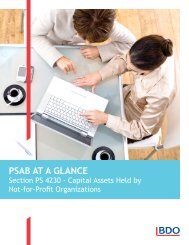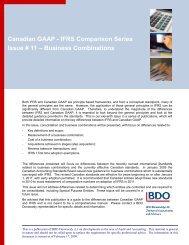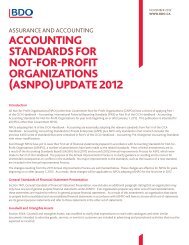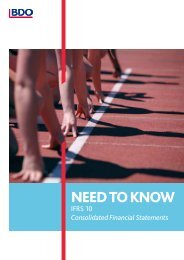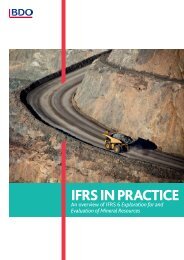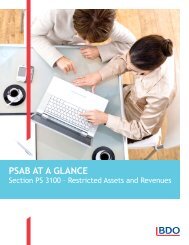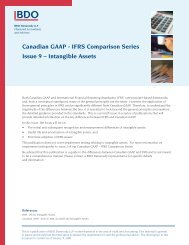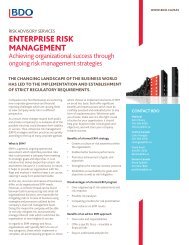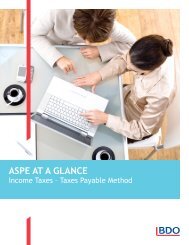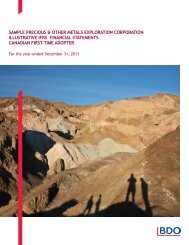need to know / leases - project update - BDO International
need to know / leases - project update - BDO International
need to know / leases - project update - BDO International
Create successful ePaper yourself
Turn your PDF publications into a flip-book with our unique Google optimized e-Paper software.
16 LEASES - A PROJECT UPDATE<br />
LESSOR ACCOUNTING<br />
Recognition and measurement<br />
The proposals will contain two approaches <strong>to</strong> lessor accounting:<br />
––<br />
The ‘receivable and residual’ approach and<br />
––<br />
An approach similar <strong>to</strong> operating lease accounting.<br />
The distinction between the two approaches would be based on the same criteria used for lessee accounting (the extent of<br />
consumption of the leased asset during the lease term) with the same practical expedient if the underlying asset is property<br />
(land and/or a building or part of a building).<br />
The receivable and residual approach would apply <strong>to</strong> <strong>leases</strong> under which the lessee acquires and consumes more than an<br />
insignificant portion of the underlying asset over the lease term.<br />
Leases of investment property measured at fair value and short term <strong>leases</strong> would be outside the scope of the new <strong>leases</strong><br />
standard, and the lessor would continue <strong>to</strong> recognise the underlying asset and recognise lease income over the lease term.<br />
Receivable and residual approach<br />
The lessor would apply the following approach:<br />
––<br />
Initially measure a receivable for the right <strong>to</strong> receive lease payments at the present value of the lease payments, discounted<br />
using the rate the lessor charges the lessee, plus direct costs. The receivable would subsequently be measured at amortised<br />
cost using the effective interest method<br />
––<br />
Initially measure the residual asset as an allocation of the carrying amount of the underlying asset. The initial measurement<br />
of the residual asset would comprise two amounts:<br />
(a) The gross residual asset, measured at the present value of the estimated residual value at the end of the lease term<br />
discounted using the rate the lessor charges the lessee; and<br />
(b) The deferred profit (that is, the element of any difference between the fair value and book value of the leased asset that<br />
relates <strong>to</strong> the retained, residual, asset), measured as the difference between the gross residual asset and the allocation<br />
of the carrying amount of the underlying asset.<br />
––<br />
Subsequently measure the gross residual asset by accreting this <strong>to</strong> the estimated residual value at the end of the lease term<br />
using the rate the lessor charges the lessee.<br />
––<br />
Defer recognition in profit or loss of the profit relating <strong>to</strong> the residual asset until the point at which that asset is sold or released.<br />
––<br />
Present the gross residual asset and the deferred profit <strong>to</strong>gether as a net residual asset.<br />
––<br />
Apply IAS 36 Impairment of Assets, when assessing whether the residual asset is impaired.



